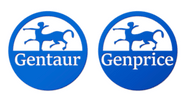Description
PAK6 Antibody | 3073 | Gentaur UK, US & Europe Distribution
Host: Rabbit
Reactivity: Human
Homology: N/A
Immunogen: PAK6 antibody was raised against a 13 amino acid synthetic peptide from near the center of human PAK6.
The immunogen is located within amino acids 260 - 310 of PAK6.
Research Area: Signal Transduction
Tested Application: E, WB, ICC, IF
Application: PAK6 antibody can be used for the detection of PAK6 by Western blot at 1 - 4 μg/mL. Antibody can also be used for immunocytochemistry starting at 10 μg/mL. For immunofluorescence start at 10 μg/mL.
Antibody validated: Western Blot in human samples; Immunocytochemistry in human samples and Immunofluorescence in human samples. All other applications and species not yet tested.
Specificiy: PAK6 antibody is predicted to not cross-react with other PAK family proteins.
Positive Control 1: Cat. No. 1207 - Raji Cell Lysate
Positive Control 2: Cat. No. 17-007 - Raji Cell Slide
Positive Control 3: N/A
Positive Control 4: N/A
Positive Control 5: N/A
Positive Control 6: N/A
Molecular Weight: Predicted: 75 kDa
Observed: 70 kDa
Validation: N/A
Isoform: N/A
Purification: PAK6 Antibody is affinity chromatography purified via peptide column.
Clonality: Polyclonal
Clone: N/A
Isotype: IgG
Conjugate: Unconjugated
Physical State: Liquid
Buffer: PAK6 Antibody is supplied in PBS containing 0.02% sodium azide.
Concentration: 1 mg/mL
Storage Condition: PAK6 antibody can be stored at 4˚C for three months and -20˚C, stable for up to one year. As with all antibodies care should be taken to avoid repeated freeze thaw cycles. Antibodies should not be exposed to prolonged high temperatures.
Alternate Name: PAK6 Antibody: PAK5, PAK5, PAK-5, PAK-6
User Note: Optimal dilutions for each application to be determined by the researcher.
BACKGROUND: PAK6 Antibody: The p21-activated kinases (PAKs) are serine-threonine kinases that bind to the active forms of Cdc42 and Rac. They are divided into two groups, the first of which include PAK1, 2 and 3, and can be activated by Cdc42/Rac binding. Group 1 PAKs contain an autoinhibitory domain whose activity is regulated by Cdc42/Rac binding. The group 1 PAKs are known to be involved in cellular processes such as gene transcription, apoptosis, and cell morphology and motility. Much less is known about the second group, which includes PAK4, 5 and 6. These proteins are not activated by Cdc42/Rac binding. PAK6 was initially identified as an androgen receptor in a yeast two hybrid screen and was found to be highly expressed in testis and prostate tissues. Later experiments have shown it to be activated by MAP kinase kinase 6 and p38 MAP kinase, suggesting that PAK6 may play a role in the cellular response to stress-related signals.



![PAK6 Antibody [APR17745G] PAK6 Antibody [APR17745G]](https://cdn11.bigcommerce.com/s-1rdwiq712m/images/stencil/590x590/products/59304/59608/gentaur-genprice__26005.1661610467__29809.1661628092__75433.1661676199__77988.1661684280__64362.1661692443__08112.1661856109.png?c=1)






